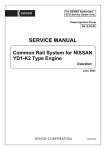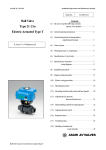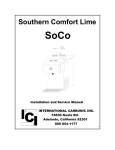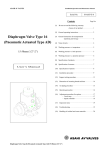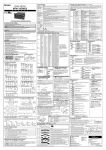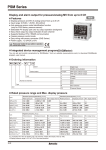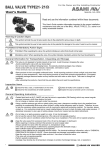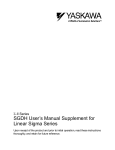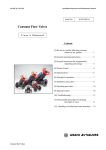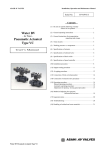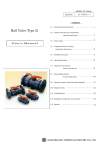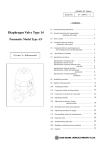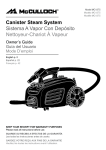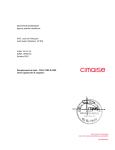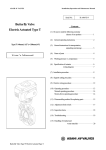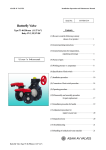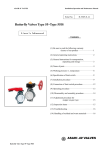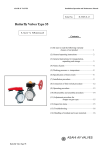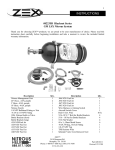Download 381.8 KB
Transcript
ASAHI AV VALVES
Installation, Operation and Maintenance Manual
Serial No.
H-A010-E-9
Contents
Control Valves
Pneumatic Actuated
Type AV
Nominal Size: 15, 25mm
Body Material: U-PVC, PVDF
Nominal Size: 50, 80, 100mm
Body Material: U-PVC
(1) Be sure to read the following warranty
clauses of our product
1
(2) General operating instructions
2
(3) General instructions for transportation,
unpacking and storage
3
(4) Name of parts
4
(5) Working pressure vs. temperature
7
(6) Specifications of valve
8
(7) Specifications of positioner
9
(8) Specifications of pressure reducing valve with filter
9
(9) Specifications of tools for
disassembling and assembling valve
10
(10) Installation procedure
11
(11) Support setting procedure
12
(12) Air piping procedure
13
(13) Connecting of E-A positioner procedure
14
(14) Operation procedure
15
(15) Method of adjustment positioner
16
(16) Disassembling method for replacing parts
17
(17) Countermeasures to avoid leakage
21
(18) Inspection items
21
(19) Troubleshooting
22
(20) Handling of residual and waste materials
22
User’s Manual
R
E
N
O
I
T
I
S
O
P
c
i
t
a
m
u
e
n
P
o
r
t
c
e
l
E
ASAHI AV VALVES
Control Valves Pneumatic Actuated Type AV
ASAHI AV VALVES
Installation, Operation and Maintenance Manual
This user’s guide contains very important information for the proper installation, maintenance and safe use of an
ASAHI AV Product. Please store this manual in an easily accessible location.
<Warning & Caution Signs>
Warning
Caution
This symbol reminds the user to take caution due to the potential for serious injury or death.
This symbol reminds the user to take caution due to the potential for damage to the valve if used in
such a manner.
<Prohibited & Mandatory Action Signs>
Prohibited: When operating the valve, this symbol indicates an action that should not be taken.
Mandatory action: When operating the valve, this symbol indicates mandatory actions that must be
adhered to.
(1)Be sure to read the following warranty clauses of our product
- Always observe the specifications of and the precautions and instructions on using our product.
- We always strive to improve product quality and reliability, but cannot guarantee perfection. Therefore,
should you intend to use this product with any equipment or machinery that may pose the risk of serious or
even fatal injury, or property damage, ensure an appropriate safety design or take other measures with
sufficient consideration given to possible problems. We shall assume no responsibility for any
inconvenience stemming from any action on your part without our written consent in the form of
specifications or other documented approval.
- The related technical documents, operation manuals, and other documentation prescribe precautions on selecting,
constructing, installing, operating, maintaining, and servicing our products. For details, consult with our nearest
distributor or agent.
- Our product warranty extends for one and a half years after the product is shipped from our factory or one year
after the product is installed, whichever comes first. Any product abnormality that occurs during the warranty
period or which is reported to us will be investigated immediately to identify its cause. Should our product be
deemed defective, we shall assume the responsibility to repair or replace it free of charge.
- Any repair or replacement needed after the warranty period ends shall be charged to the customer.
- The warranty does not cover the following cases:
(1) Using our product under any condition, not covered by our defined scope of warranty.
(2) Failure to observe our defined precautions or instructions regarding the construction, installation, handling,
maintenance, or servicing of our product.
(3) Any inconvenience caused by any product other than ours.
(4) Remodeling or otherwise modifying our product by anyone other than us.
(5) Using any part of our product for anything other than the intended use of the product.
(6) Any abnormality that occurs due to a natural disaster, accident, or other incident not stemming from
something inside our product.
Control Valves Pneumatic Actuated Type AV
1
ASAHI AV VALVES
Installation, Operation and Maintenance Manual
(2) General operating instructions
Warning
Caution
- Do not disassemble or modify the actuator.
(If disassembled forcible, internal parts may jump out and this is very dangerous.)
- Using a positive-pressure gas with our plastic piping may pose a hazard due to the repellent force
particular to compressible fluids even when the gas is under similar pressures used for liquids.
Therefore, be sure to take the necessary safety precautions such as covering the piping with protective
material. For inquiries, please contact us. For conducting a leak test on newly installed piping, be
sure to check for leaks under water pressure. If absolutely necessary to use a gas in testing, please
consult your nearest service station beforehand.
- Do not step on or apply excessive weight on valve. (It can be damaged.)
- Do not use AV valves in a place where they may become submerged in water.
- Do not remove a dust-proof cap provided to piping port before piping work starts.
- Do not use the valve in conditions where the fluid may have crystallized.
(The valve will not operate properly.)
- Keep the valve away from excessive heat or fire. (It can be damaged, or destroyed.)
- Always operate the valve within the pressure vs. temperature range.
(The valve can be damaged or deformed by operating beyond the allowable range.)
- Allow sufficient space for maintenance and inspection.
- Select a valve material that is compatible with the media. For chemical resistance information, refer to
“CHEMICAL RESISTANCE ON ASAHI AV VALVE”.
(Some chemicals may damage incompatible valve materials.)
- Keep the valve out of direct sunlight, water and dust. Use cover to shield the valve.
(The valve will not operate properly.)
- Perform regular maintenance. (Leakage may develop due to temperature changes or periods of
prolonged storage, rest, or operation.)
- Set valve support on the valve.
- The AV valves must be used within the specifications specifically applicable to the Product.
Control Valves Pneumatic Actuated Type AV
2
ASAHI AV VALVES
Installation, Operation and Maintenance Manual
(3) General instructions for transportation, unpacking and storage
- When suspending and supporting a valve, take care and do not stand under a suspended valve.
Warning
Caution
- This valve is not designed to handle impacts of any kind. Avoid throwing or dropping the valve.
- Avoid scratching the valve with any sharp object.
- Do not over-stack cardboard shipping boxes. Excessively stacked packages may collapse.
- Avoid contact with any coal tar creosote, insecticides, vermicides or paint.
(These chemicals may cause damage to the valve.)
- Store products in their corrugated cardboard boxes. Avoid exposing products to direct sunlight, and
store them indoors (at room temperature). Also avoid storing products in areas with excessive
temperatures. (Corrugated cardboard packages become weaker as they become wet with water or
other liquid. Take care in storage and handling.)
- After unpacking the products, check that they are defect-free and meet the specifications.
Control Valves Pneumatic Actuated Type AV
3
ASAHI AV VALVES
Installation, Operation and Maintenance Manual
(4) Name of parts
Nominal size: 15, 25mm (1/2”, 1”) / Body material: U-PVC
*Drawing shows E-A positioner of “Air to open” type.
R
E
N
O
I
T
I
S
O
P
c
i
t
a
m
u
e
n
P
o
r
t
c
e
l
E
No.
[1]
[3]
[4]
[5]
[7]
[9]
Description
Body
Orifice
Plug
Piston (A)
Bush
Stop ring
Control Valves Pneumatic Actuated Type AV
No.
[10]
[11]
[12]
[16]
[19]
[20]
Description
Seat
O ring(A)
O ring(B)
Name plate
Stand
Actuator
No.
[25]
[31a]
[41]
[42]
[54]
Description
Stem
Positioner
Bolt・Nut (A)
Bolt・Nut (B)
Screw (B)
4
ASAHI AV VALVES
Installation, Operation and Maintenance Manual
Nominal size: 15, 25mm (1/2”, 1”) / Body material: PVDF
*Drawing shows E-A positioner of “Air to open” type.
R
E
N
O
I
T
I
S
O
P
c
i
t
a
m
u
e
n
P
o
r
t
c
e
l
E
No.
[1]
[3]
[5]
[10]
[11]
[12]
Description
Body
Orifice
Piston (A)
Seat
O ring(A)
O ring(B)
Control Valves Pneumatic Actuated Type AV
No.
[16]
[19]
[20]
[25]
[31a]
[41]
Description
Name plate
Stand
Actuator
Stem
Positioner
Bolt・Nut (A)
No.
[42]
[54]
[57]
[58]
[59]
[60]
Description
Bolt・Nut (B)
Screw (B)
V-Packing
Packing holder
Stopper
Piston guide
5
ASAHI AV VALVES
Installation, Operation and Maintenance Manual
Nominal size: 50, 80, 100mm (2”, 3”, 4”) / Body material: U-PVC
*Drawing shows E-A positioner of “Air to open” type.
R
E
N
O
I
T
I
S
O
P
c
i
t
a
m
u
e
n
P
o
r
t
c
e
l
E
No.
[1]
[4]
[5]
[7]
[8]
Description
Body
Plug
Piston (A)
Bush
Bush guide
Control Valves Pneumatic Actuated Type AV
No.
[9]
[10]
[11]
[12]
[14]
Description
Stop ring
Seat
O ring (A)
O ring (B)
O ring (D)
No.
[19]
[20]
[31a]
[41]
[54]
Description
Stand
Actuator
Positioner
Bolt・Nut (A)
Screw (B)
6
ASAHI AV VALVES
Installation, Operation and Maintenance Manual
(5) Working pressure vs. temperature
Control Valves Pneumatic Actuated Type AV
7
ASAHI AV VALVES
Installation, Operation and Maintenance Manual
(6) Specifications of valve
15mm(1/2”)
Nom. Size
25mm(1”)
50mm(2”)
80mm(3”)
100mm(4”)
Type
Double acting
Air to open
Type of Nom. size
Double acting
Air to open
Rated pressure
(MPa{kgf/cm2})
Double acting
Air to open
1.0{10.2}
1.0{10.2}
1.0{10.2}
0.75{7.6}
0.75{7.6}
Double acting
0.7{7.1}
0.7{7.1}
0.7{7.1}
0.65{6.6}
0.65{6.6}
Air to open
0.7{7.1}
0.7{7.1}
0.7{7.1}
0.7{7.1}
0.7{7.1}
Double acting
Air to open
Double acting
Air to open
Double acting
Air to open
Equal %
or linear
-Standard 50:1
-Minute 20:1
0.4-0.7
{4.1-7.1}
Equal %
or linear
Equal %
Equal %
Equal %
50:1
50:1
50:1
50:1
0.4-0.7
{4.1-7.1}
0.4-0.7
{4.1-7.1}
0.4-0.7
{4.1-7.1}
0.4-0.7
{4.1-7.1}
Double acting
0.6
0.7
2.1
2.1
6.3
Air to open
1.3
1.5
2.7
5.5
7.9
Shut off pressure
(MPa{kgf/cm2})
Flow characteristic
Inherent
rangeability
Operating pressure
(MPa{kgf/cm2})
Air consumption
Nl per 1 open and
close
(MPa{kgf/cm2})
Air supply bore
Single seated control valve Air cylinder type
- Standard control
- Standard
type
- Minute control control type
type
Double acting
Air to open
Control Valves Pneumatic Actuated Type AV
- Large size control type
Rc 1/4
8
ASAHI AV VALVES
Installation, Operation and Maintenance Manual
(7) Specification of positioner
E-A positioner
Actuation
Double
action
Air to
open
Nom. Size
15mm (1/2”),
25mm(1”)
50mm(2”),
80mm(3”),
100mm(4”)
15mm (1/2”),
25mm(1”)
50mm(2”),
80mm(3”),
100mm(4”)
Type Sign
Input signal
electric current
/resistance
Air pipe bore
Electrical
connection bore
Protection
grade
DC4-20mA
/250Ω
Rc1/4
G1/2
ExdⅡBT5
YT-1000L-DJ111S
YT-1000L-DJ131S
YT-1000L-SJ111S
YT-1000L-SJ131S
A-A positioner
Actuation
Double
action
Air to
open
Nom. Size
15mm (1/2”),
25mm(1”)
50mm(2”),
80mm(3”),
100mm(4”)
15mm (1/2”),
25mm(1”)
50mm(2”),
80mm(3”),
100mm(4”)
Input signal air
pressure
(MPa {kgf/cm2})
Air pipe bore
Protection grade
0.02(0.2)-0.10(1.0)
Rc1/4
IP66
Type Sign
YT-1200L-D111S
YT-1200L-D131S
YT-1200L-S111S
YT-1200L-S131S
(8) Specification of pressure reducing valve with filter
Action
Double
action
Air to open
Nom. size
Type sign
Pipe bore
15mm (1/2”)
25mm(1”)
50mm(2”)
80mm(3”)
100mm(4”)
Element
degree of
filtration
AUR02
Rc1/4
5μm
Control Valves Pneumatic Actuated Type AV
9
ASAHI AV VALVES
Installation, Operation and Maintenance Manual
(9) Specification of tools for disassembling and assembling valve
Orifice remover
Dimension table
Nom. size
1
15mm
/2”
25mm
1”
D1
23.5
37.5
D2
35.5
49.5
Control Valves Pneumatic Actuated Type AV
L1
2.5
2.5
L2
60
80
L3
115
125
e
2.5
2.5
10
ASAHI AV VALVES
Installation, Operation and Maintenance Manual
(10) Installation procedure
- Do not use the valve to fluid containing slurry. (The valve will not operate properly.)
Warning
- The installed valve must never be opened or closed when foreign matter such as sand is present in the
pipeline.
- Use flat faced flanges for connection to AV Valves.
- Ensure that the mating flanges are of the same standards.
- Be sure to use sealing gaskets (AV Gasket), bolts, nuts, and washers and tighten them to specified
torques. (When a non-AV gasket is used, a different tightening torque specification should be
followed.)
- When installing a pipe support by means of a U-band or something similar, take care not to over-tighten.
(Excessive force may damage the pipe.)
- When connecting a ASAHI AV Valve to metal piping, take care not to let the pipe stress on the ASAHI
AV Valve.
Necessary items
● Torque wrench
● AV gasket
Procedure
1) Set the AV gasket between the flanges.
2) Insert washers and bolts from the pipe side, insert washers and nuts from the valve side, then temporarily
tighten them by hand.
Caution
- The parallelism and axial misalignment of the flange surface should be under the values shown in the
following table to prevent damage the valve.
(A failure to observe them can cause destruction due to stress application to the pipe)
Unit: mm (inch)
Nom. Size
Axial
Misalignment
Parallelism
(a-b)
15, 25mm
(1/2”, 1”)
50, 80
(2”, 3”)
100
(4”)
1.0
(0.04)
1.0
(0.04)
1.0
(0.04)
0.5
(0.02)
0.8
(0.03)
1.0
(0.04)
(Axial misalignment)
(Parallelism)
3) Using a torque wrench, tighten the bolts and nuts gradually to the specified torque in a diagonal manner
(Refer to fig.1.)
Control Valves Pneumatic Actuated Type AV
11
ASAHI AV VALVES
Installation, Operation and Maintenance Manual
Recommended torque value
15 mm
Nom. Size
(1/2”)
PTFE・PVDF
17.5{179}[155]
coated
Rubber
8.0{82}[71]
Unit: N・m{kgf・cm}[lb・inch]
50 mm
80, 100 mm
(2”)
(3”, 4”)
25 mm
(1”)
20.0{204}[177]
22.5{230}[230]
30.0{306}[266]
20.0{204}[177]
22.5{230}[230]
30.0{306}[266]
Fig. 1
(11) Support setting procedure
- Do not subject the valve to pump vibrations. (The valve may be damaged.)
Caution
- When installing a pipe support by means of a U-band or something similar, take care not to fasten it
too much. (Excessive tension may damage it.)
- Valves must be supported. (The valve may be damaged by the weight of the actuator if it is unsupported.)
Necessary items
● Spanner wrench
● U-type clamp (with bolt)
● Rubber sheet
Level installation
Level installation
Set the stand under the valve.
R
E
N
O
I
T
I
S
O
P
c
i
t
a
m
u
e
n
P
o
r
t
c
e
l
E
Only for nominal size 15, 25mm (1/2”, 1”), the Ensat
which is equipped to the body enables the valve to fix
to the stand. Refer to the chart below.
U-type clamp
Rubber sheet
Dimension of Ensat
Nominal Size
Ensat
15, 25mm (1/2”, 1”)
M6
Spread the rubber sheet on the pipe and secure with
U-type clamp.
Control Valves Pneumatic Actuated Type AV
Stand
Ensat
12
ASAHI AV VALVES
Installation, Operation and Maintenance Manual
Perpendicular installation
Perpendicular installation
Set the stand under the actuator and the actuator stand.
U-type clamp
Rubber sheet
Only for nominal size 15, 25mm (1/2”, 1”), the Ensat
which is equipped to the body enables the valve to fix
to the stand. Refer to the chart above.
R
E
N
O
I
T
I
S
O
P
ic
t
ma
eu
Pn
otr
ec
El
Spread the rubber sheet on the pipe and secure with
U-type clamp.
Stand
(12) Air piping procedure
<1> For a standard type and an attached speed controller type
Caution
- Do not remove a dust-proof cap provided to piping port before piping work starts.
- Avoid excessive tightening. (The threaded area of a pipe can be damaged.)
- Do not apply a sealant excessively lest it fall off in the pipeline when an actuator is piped.
- Check the connection locations, air pipe sizes, and screw types with the approved drawings and other
documents for the product. Then lay the air piping.
- The operating fluid must be clean air filtered through a pertinent air filter.
- If the actuator is used in an environment below 5℃ temperature, its operating fluid must be free from
the water and moisture contained in it because of possible problems due to the freeze.
- Steel pipes must always be of the plated.
- Before installing an actuator in pipeline, flash the inside of pipeline completely.
- Threaded area of a pipe must be free from the sharp edges and burr.
Necessary items
● Steel pipe or tube for piping
● Joint for steel pipe or tube
Control Valves Pneumatic Actuated Type AV
● Spanner wrench
● Seal tape (If seal tape isn’t used, leakage may be caused)
13
ASAHI AV VALVES
Installation, Operation and Maintenance Manual
E-E positioner
Procedure
R
E
N
O
I
T
I
S
O
P
)
P
/
P
(
c
i
t
a
m
u
e
n
P
1) Wind a seal tape onto the male screw of the joint with a blank about
3mm (about 2 threads) left at the end.
2) Tighten the joint to the piping port of positioner or pressure
reducing valve with filter by hand.
E-A positioner
3) Screw the joint one turn with a spanner wrench.
* Avoid excessive tightening.
(The valve can be damaged.)
R
E
N
O
I
T
I
S
O
P
c
i
t
a
m
u
e
n
P
o
r
t
c
e
l
E
4) Mount a steel pipe or a tube.
*E-A positioner has no signal air piping port.
(13) Connection of electric-pneumatic positioner procedure
Necessary items
● Screwdriver (+)
● Allen wrench
● Connector (G1/2)
● Wire stripper
● Terminal crimping tool
Procedure
1) Loosen the terminal cover attaching a screwdriver (+) to the
space of terminal board cover.
2) Pull the piping port protective cap off.
R
E
N
O
I
T
I
S
O
P
c
i
t
a
m
u
e
n
P
o
r
t
c
e
l
E
3) Draw the cable thorough the connector.
4) Strip the cable with a wire stripper.
5) Loosen screws of the crimp-style terminal, which is in the
terminal board with a screwdriver (+) and remove it.
Fig.2
6) Install the crimp-style terminal on the lead wire with a
terminal-crimping tool.
7) Connect to the terminal screws with a screwdriver in accordance
with the indication of terminal board. (Refer to fig.2)
※Tighten the screws. (If not, electric leaks or shocks may occur.)
Control Valves Pneumatic Actuated Type AV
14
ASAHI AV VALVES
Installation, Operation and Maintenance Manual
8) Tighten the connector to fix the cable.
9) Tighten the terminal board cover to the terminal board by hand.
10) Tighten the terminal board cover attaching the screwdriver (+) to the space of terminal board cover.
11) Tighten screws fixed the terminal board with a hexagon wrench.
(14) Operating procedure
- As for the E-A positioner, do not leave the terminal board cover. (The valve may be damaged.)
Caution
- Keep air supply pressure form the pressure reducing valve with filter at least 0.4MPa {4.1kgf/cm2}
(The valve may not function.)
Procedure
1) Supply air to the air supply opening.
2) Input the signal electric current, DC4-20mA for the E-A positioner and 0.02MPa {0.2kfg/cm2}
[2.9psi] - 0.10MPa{1.0kgf/cm2} [14.5psi] for the A-A positioner.
3) Change the input signal and make sure that the travel indicator shows as below.
Input signal for E-A positioner (mA)
4
8
12
16
20
Input signal for A-A positioner
(MPa {kgf/cm2} [psi])
0.02 {0.2}
[2.9]
0.04 {0.4}
[5.8]
0.06 {0.6}
[8.7]
0.08 {0.8}
[11.6]
0.10 {1.0}
[14.5]
The valve travel indicator (%)
0
25
50
75
100
4) Turn off the input signal.
5) Stop supplying air.
Control Valves Pneumatic Actuated Type AV
15
ASAHI AV VALVES
Installation, Operation and Maintenance Manual
(15) Method of adjusting positioner
Necessary items
● Screwdriver (+)
● Screwdriver (-)
Procedure
1) Loosen the screws fixed the positioner cover with a
screwdriver (+) and remove the cover.
Zero Point adjusting Knob
2) Supply air to the air supply bore.
3) Input the signal electric current, DC4mA for the E-A
positioner. (Input the signal air, 0.02MPa{0.2kfg/cm2} for the
A-A positioner.)
4) Fully close the valve turning the zero point adjusting knob
“+” and “-”.
5)
Input the signal electric current, DC20mA for the E-A
positioner. (Input the signal air, 0.02MPa{0.2kfg/cm2} for the
A-A positioner.)
Range adjusting Knob
6) Loosen the lock screw fixed the range adjuster with a
screwdriver (+).
Range Adjuster
7) Fully open the valve turning the range adjuster.
8) Change the input signal and make sure that the signal and the
travel indicator accord with each other. (Refer to page 13)
Lock Screw
9) Tighten the lock screw fixed the range adjuster with a
screwdriver (+).
10) Fix the positioner cover and tighten the screws with a screwdriver (+).
Control Valves Pneumatic Actuated Type AV
16
ASAHI AV VALVES
Installation, Operation and Maintenance Manual
(16) Disassembling method for replacing parts
Warning
- Never attempt to disassemble an actuator.
(If disassembled forcible, internal parts may jump out and this is very dangerous.)
- Be sure to conduct a safety check on all hand and power tools to be used before beginning work.
- Wear protective gloves and safety goggles as fluid remain in the valve even if the pipeline is empty.
(You may be injured.)
Nominal size: 15, 25mm (1/2”, 1”) / Body material: U-PVC, PVDF / Air to open
Necessary items
● Protective gloves
● Safety goggles
● Allen wrench
● Marker pen
● Screwdriver (-) (Only required for PVDF made Products)
● Spanner wrench
● Orifice remover
<Disassembly>
Procedure
1) Completely discharge fluid from pipes.
2) Close the main valve for air and discharge air from the actuator.
3) Remove the air piping from air supply bore of positioner.
4) As for the E-A positioner, turn off the electric input signal and remove the wiring.
As for the A-A positioner, close the main valve for input signal air, and set the input signal pressure at zero then
remove the input signal air pipe.
5) Loosen and remove the bolt-nut of coupled flange.
6) Remove the valve from the pipe.
7) Loosen the joint of air piping port on the actuator [20] side and remove it.
8) Supply the air, 0.4MPa (4.1kgf/cm2) [58 psi], to the air piping port of actuator [20] and open the valve fully.
9) Put a mark between the actuator [20] and body [1] with a marker pen.
10) Loosen the coupled bolt-nuts [41] of the body [1] and stand [19] and remove them.
11) Lift the actuator [20] with stand [19] up and remove it from the body.
* Lift the actuator [20] up gently and perpendicularly. (Parts may be scratched.)
12) Stop supplying air to the actuator [20] and discharge it to close.
13) Loosen the screw (B) [54].
14) Turn the piston (A) [5] counterclockwise and remove it without damaging it.
15) Loosen the coupled bolt-nuts [42] of the actuator [20] and stand [19] and remove them.
Body material: U-PVC
16) Remove the stop ring [9] from the piston (A) [5].
17) Pull the bush [7] out of the piston (A) [5].
* The plug [4] can not be removed because it is screwed in the piston (A) [5] after adhered.
(If removed by force, the valve may be damaged.)
18) Loosen the orifice [3] with a tool for turning the orifice and remove it.
Body material: PVDF
16) Pull the piston guide [60] out of the piston (A) [5].
17) Loosen the stopper [59] and the packing holder [58] and remove them from the stand [19].
18) Loosen the orifice [3] with an orifice remover, turn the orifice and remove it.
Control Valves Pneumatic Actuated Type AV
17
ASAHI AV VALVES
Installation, Operation and Maintenance Manual
<Assembly>
Procedure
1) Before starting assembly, silicone grease (fluorine grease is suitable for the chlorine fluid) should be spread on the
sliding surfaces and sealing parts, for instance, body [1], piston (A) [5], bush [7] (body material: U-PVC), piston
guide [60] (body material: PVDF) and each O-rings.
2) Carry out the assembly work in the reverse procedure from item 18).
*When tightening the bolt・nut [41], tighten them lightly, and open and close the valve a few times. Make sure that
there isn’t any problem, then tighten them up completely.
Nominal size: 15, 25mm (1/2”, 1”) / Body material: U-PVC, PVDF / Double acting
Necessary items
● Protective gloves
● Safety goggles
● Allen wrench
● Marker pen
● Screwdriver (-) (Only required for PVDF made Products)
● Spanner wrench
● Orifice remover
<Disassembly>
Procedure
1) Completely discharge fluid from pipes.
2) Close the main valve for air and discharge air from the actuator.
3) Remove the air piping.
4) As for the E-A positioner, turn off the electric input signal and remove the wiring.
As for the A-A positioner, close the main valve for input signal air, and set the input signal pressure at zero then
remove the input signal air pipe.
5) Loosen and remove the bolt-nut of coupled flange.
6) Remove the valve from the pipe.
7) Loosen the joint of air piping port on the actuator [20] side and remove it.
8) Put a mark between the actuator [20] and body [1] with a marker pen.
9) Loosen the coupled bolt-nuts [41] of the body [1] and stand [19] and remove them.
10) Lift the actuator [20] with stand [19] up and remove it from the body [1].
* Lift the actuator [20] up gently and perpendicularly. (Parts may be scratched.)
11) Loosen the screw (B) [54].
12) Turn the piston (A) [5] counterclockwise and remove it without damaging it.
13) Loosen the coupled bolt-nuts [42] of the actuator [20] and stand [19] and remove them.
Body material: U-PVC
14) Remove the stop ring [9] from the piston (A) [5].
15) Pull the bush [7] out of the piston (A) [5].
* The plug [4] can not be removed because it is screwed in the piston (A) [5] after adhered
(If removed by force, the valve may be damaged.)
16) Loosen the orifice [3] with a tool for turning the orifice and remove it.
Body material: PVDF
14) Pull the piston guide [60] out of the piston (A) [5].
15) Loosen the stopper [59] and the packing holder [58] and remove them from the stand [19].
16) Loosen the orifice [3] with an orifice remover, turn the orifice and remove it.
Control Valves Pneumatic Actuated Type AV
18
ASAHI AV VALVES
Installation, Operation and Maintenance Manual
<Assembly>
Procedure
1) Before starting assembly, silicone grease (fluorine grease is suitable for the chlorine fluid) should be spread on the
sliding surfaces and sealing parts, for instance, body [1], piston (A) [5], bush [7] (body material: U-PVC), piston
guide [60] (body material: PVDF) and each O-rings.
2) Carry out the assembly work in the reverse procedure from item 16).
*When tightening the bolt・nut [41], tighten them lightly, and open and close the valve a few times. Make sure that
there isn’t any problem, then tighten them up completely.
Nominal size: 50, 80, 100mm (2”, 3”, 4”) / Body material: U-PVC / Air to open
Necessary items
● Protective gloves
● Allen wrench
● Safety goggles
● Marker pen
● Spanner wrench
<Disassembly>
Procedure
1) Completely discharge fluid from pipes.
2) Close the main valve for air and discharge air from the actuator.
3) Remove the air piping.
4) As for the E-A positioner, turn off the electric input signal and remove the wiring.
As for the A-A positioner, close the main valve for input signal air, and set the input signal pressure at zero then
remove the input signal air pipe.
5) Loosen and remove the bolt-nut of coupled flange.
6) Remove the valve from the pipe.
7) Loosen the joint of air piping port on the actuator [20] side and remove it.
8) Supply the air, 0.4MPa {4.1kgf/cm2} [58psi], to the air piping port of actuator [20] and open the valve fully.
9) Put a mark between the actuator [20] and body [1] with a marker pen.
10) Loosen the coupled bolt-nuts [41] of the body [1] and stand [19] and remove them.
11) Lift the actuator [20] with stand [19] up and remove it from the body [1].
* Lift the actuator [20] up gently and perpendicularly. (Parts may be scratched.)
12) Stop supplying air to the actuator [20] and discharge it to close.
13) Loosen the screw (B) [54].
14) Loosen the piston (A) [5] counterclockwise and remove it without damaging it.
15) Pull the bush guide [8] out of the bush [7].
16) Remove the stop ring [9] from the piston (A) [5].
17) Pull the bush [7] out of the piston (A) [5].
* The plug [4] can not be removed because it is screwed in the piston (A) [5] after adhered.
(If removed by force, the valve may be damaged.)
<Assembly>
Procedure
1) Before starting assembly, silicone grease (fluorine grease is suitable for the chlorine fluid) should be spread on the
sliding surface and sealing parts, for instance, body [1], piston (A) [5], bush [7], bush guide [8], each O-rings.
2) Carry out the assembly work in the reverse procedure from item 17).
*When tightening the bolt・nut [41], tighten them lightly, and open and close the valve a few times. Make sure that
there isn’t any problem, then tighten them up completely.
Control Valves Pneumatic Actuated Type AV
19
ASAHI AV VALVES
Installation, Operation and Maintenance Manual
Nominal size: 50, 80, 100mm (2”, 3”, 4”) / Body material: U-PVC / Double acting
Necessary items
● Protective gloves
● Allen wrench
● Safety goggles
● Marker pen
● Spanner wrench
<Disassembly>
Procedure
1) Completely discharge fluid from pipes.
2) Close the main valve for air and discharge air from the actuator.
3) Remove the air piping.
4) As for the E-A positioner, turn off the electric input signal and remove the wiring.
As for the A-A positioner, close the main valve for input signal air, and set the input signal pressure at zero then
remove the input signal air pipe.
5) Loosen and remove the bolt-nut of coupled flange.
6) Remove the valve [1] from the pipe.
7) Loosen the joint of air piping port on the actuator [20] side and remove it.
8) Put a mark between the actuator [20] and body [1] with a marker pen.
9) Loosen the coupled bolt-nuts [41] of the body [1] and stand [19] and remove them.
10) Lift the actuator [20] with stand [19] up and remove it from the body [1].
* Lift the actuator [20] up gently and perpendicularly. (Parts may be scratched.)
11) Loosen the screw (B) [54].
12) Turn the piston (A) [5] counterclockwise and remove it without damaging it.
13) Pull the bush guide [8] out of the bush [7].
14) Remove the stop ring [9] from the piston (A) [5].
15) Pull the bush [7] out of the piston (A) [5].
* The plug [4] can not be removed because it is screwed in the piston (A) [5] after adhered
(If removed by force, the valve may be damaged.)
<Assembly>
Procedure
1) Before starting assembly, silicone grease (fluorine grease is suitable for the chlorine fluid) should be spread on the
sliding surface and sealing parts, for instance, body [1], piston (A) [5], bush [7], bush guide [8], each O-rings.
2) Carry out the assembly work in the reverse procedure from item 15).
*When tightening the bolt・nut [41], tighten them lightly, and open and close the valve a few times. Make sure that
there isn’t any problem, then tighten them up completely.
Control Valves Pneumatic Actuated Type AV
20
ASAHI AV VALVES
Installation, Operation and Maintenance Manual
(17) Countermeasures to avoid leakage (only for body material PVDF)
Warning
- Be sure to conduct a regular replacement of damaged parts for permanent measures. (The structure of
tightening the ‘Packing Holder’ is for emergency measures against the leakage from the slide piston.)
- Do not tighten the stopper and the packing holder excessively. (Can damage the products)
Caution
- Perform regular maintenance. (Leakage may develop due to temperature changes or over periods of
prolonged storage, rest or in operation.)
Necessary items
● Protective gloves
● Safety goggles
● Screwdriver (-)
Procedure
1) Turn the stopper [59] counterclockwise by using a screwdriver.
2) Tighten the packing holder [58] clockwise by using a screwdriver properly.
3) Fix the packing holder [58] and tighten the stopper [59] clockwise.
(18) Inspection items
Caution
- Perform regular maintenance. (Leakage may develop due to temperature changes or over periods of
prolonged storage, rest or operation.)
○ Periodically inspect and maintain the AV valve in accordance with the decided schedule.
Portion to be inspected
Inspection item
- Existence of rust, corrosion.
- Tightening condition of respective threaded portions. (Loose or not)
Actuator
- Existence of abnormality in opening and closing operating sounds.
* It is unnecessary to supply oil to this actuator.
- Existence of scratches, cracks, deformation, and discoloring.
Valve
- Tightening condition of respective threaded portions. (Loose or not)
- Existence of leakage when the valve is closed fully.
- Existence of scratches, cracks, deformation, discoloring and rust.
Positioner
- Tightening condition of respective threaded portions. (Loose or not)
- Existence of air leakage from the air piping.
Control Valves Pneumatic Actuated Type AV
21
ASAHI AV VALVES
Installation, Operation and Maintenance Manual
(19) Troubleshooting
Problem
Cause
Treatment
The input signal can not be inputted in to the
Input the input signal.
positioner.
The connection of input signal for the E-A Check the connection.
positioner is disconnected.
(Refer to page 13)
The valve does not operate.
Air is not supplied.
Supply air.
The air pressure is low.
Check the air pressure.
Foreign matter is in the valve.
Disassemble the valve to remove
foreign matter. (Refer to page 11)
The seat is worn.
Replace the seat with a new one.
The seat, piston or body is scratched.
Fluid leaks from the valve
even when the valve is closed
fully.
Foreign matter is in the valve.
Zero point shifted.
Replace the scratched seat, piston or
body with new ones..
Discharge the foreign matter from the
valve by opening and closing the
valve several times.
Adjust the positioner.
The O ring is scratched or worm.
Replace the O ring with a new one.
Fluid leaks from the valve.
The O ring is projected from the groove.
The sliding face or the fixed face of the
O ring is scratched or worm.
Replace the sliding face or the fixed
face with a new one.
(20) Handling of residual and waste materials
Warning
- Make sure to consult a waste treatment dealer for recommendations on the proper disposal of plastic valves.
(Poisonous gas is generated when the valve is burned improperly.)
Control Valves Pneumatic Actuated Type AV
22
ASAHI AV VALVES
Installation, Operation and Maintenance Manual
Control Valves
Pneumatic Actuated Type AV
[Automatic Valve]
ASAHI AV VALVES
Distributor
Asahi Organic Chemicals Industry’s homepage
Information in this manual is subject to change without notice.
Control Valves Pneumatic Actuated Type AV
http://www.asahi-yukizai.co.jp/en/
2012.8
























